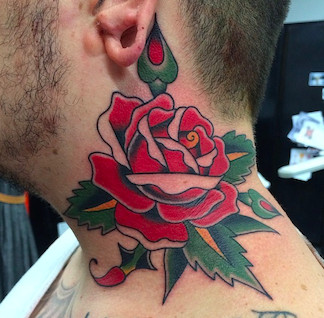Are Neck Tattoos A Bad Idea? Absolutely, neck tattoos can be a bold expression of individuality. However, it’s crucial to consider the social implications and personal commitment involved before getting inked. At tattooat.com, we aim to provide you with comprehensive insights into the world of tattoos, helping you make informed decisions about body art and tattoo culture. Let’s delve into the details to help you decide if a neck tattoo is the right choice for you, covering everything from tattoo placement to career considerations, and alternative options for self-expression through body modification.
1. Understanding Neck Tattoos: An Overview
Neck tattoos are a significant form of body art, known for their visibility and the strong statement they make. Before deciding to get one, it’s essential to understand what they entail.
What is a Neck Tattoo?
A neck tattoo is any tattoo placed on the neck, including the front, back, and sides. These tattoos are highly visible and can range from small, discreet designs to large, elaborate pieces. The neck is a relatively sensitive area, so pain levels can be a significant factor in the decision-making process.
Why Do People Get Neck Tattoos?
People choose neck tattoos for various reasons:
- Self-Expression: Neck tattoos can be a powerful way to express individuality and personal beliefs.
- Aesthetic Appeal: Many find neck tattoos visually appealing and a way to enhance their personal style.
- Rebellion and Nonconformity: Neck tattoos have historically been associated with rebellion and a rejection of mainstream norms.
- Artistic Statement: Some view their bodies as canvases and choose the neck as a prominent location to display art.
Common Neck Tattoo Designs
Neck tattoo designs vary widely based on personal preference, including:
- Geometric Patterns: These can create a modern and striking look.
- Floral Designs: Popular for their beauty and symbolism.
- Script and Lettering: Often used to display meaningful quotes or names.
- Tribal Art: Reflecting cultural heritage and personal identity.
- Abstract Art: Allowing for unique and creative expressions.
2. The Social and Professional Implications
One of the most significant considerations before getting a neck tattoo is its potential impact on your social and professional life.
Perception in the Workplace
Neck tattoos can be perceived differently in various professional settings. While some industries are becoming more accepting of visible tattoos, others remain conservative.
- Conservative Industries: Fields like finance, law, and traditional healthcare may view neck tattoos negatively.
- Creative Industries: Industries such as art, music, fashion, and tech are generally more accepting.
- Customer Service: Depending on the company culture, visible tattoos could affect customer interactions.
According to a 2023 study by Portland State University’s Art Department, approximately 60% of employers in the US still hold some reservations about visible tattoos, particularly in client-facing roles.
Social Stigma and Stereotypes
Despite increasing acceptance, social stigmas surrounding tattoos persist. Neck tattoos, due to their visibility, can attract more attention and judgment.
- Public Perception: People may make assumptions about your personality, lifestyle, and values based on your tattoos.
- Social Interactions: You might encounter prejudice or discomfort in social situations.
- Family and Community: Depending on your family’s and community’s values, a neck tattoo could lead to disapproval or conflict.
Strategies for Managing Perceptions
If you’re determined to get a neck tattoo, there are ways to mitigate potential negative perceptions:
- Consider Placement: Opt for a less visible area of the neck, if possible.
- Choose the Design Wisely: Select a design that is tasteful and not offensive.
- Be Confident and Professional: Your attitude and behavior can help change perceptions.
- Know Your Rights: Understand workplace policies regarding tattoos and be prepared to advocate for yourself if necessary.
3. Pain and Healing: What to Expect
The neck is a sensitive area, and getting a tattoo there can be more painful than in other locations. Understanding the pain and healing process is crucial.
Pain Levels
The level of pain experienced during a neck tattoo varies depending on individual pain tolerance, tattoo placement, and the artist’s technique.
- Areas of Higher Pain: The front and sides of the neck, due to thinner skin and nerve endings, tend to be more painful.
- Areas of Lower Pain: The back of the neck, where there is more muscle and tissue, may be less painful.
The Tattooing Process
The tattooing process for the neck is similar to other areas but requires extra care due to the skin’s sensitivity and location.
- Consultation: Discuss your design and placement with the artist.
- Preparation: The area will be shaved, cleaned, and possibly numbed.
- Stenciling: The design is transferred to your skin.
- Tattooing: The artist uses a tattoo machine to apply the ink.
Aftercare and Healing
Proper aftercare is essential for ensuring your neck tattoo heals correctly and to prevent infection.
- Keep it Clean: Gently wash the tattoo with mild soap and water.
- Moisturize: Apply a thin layer of tattoo-friendly ointment or lotion.
- Avoid Sun Exposure: Protect the tattoo from direct sunlight.
- Don’t Pick or Scratch: Let the tattoo heal naturally.
- Stay Hydrated: Drink plenty of water to promote healing.
According to Inked Magazine, neck tattoos typically take about 2-3 weeks to heal fully, but this can vary depending on individual factors and how well the aftercare instructions are followed.
 A detailed neck tattoo featuring intricate floral patterns
A detailed neck tattoo featuring intricate floral patterns
4. Considerations for Tattoo Placement and Size
The placement and size of your neck tattoo can significantly impact its visibility and overall aesthetic.
Placement Options
- Front of the Neck: Bold and highly visible, suitable for those seeking a strong statement.
- Back of the Neck: More discreet, can be easily covered with hair or clothing.
- Side of the Neck: Visible but can be partially hidden, offering a balance between expression and subtlety.
- Nape of the Neck: A popular choice for smaller, more personal designs.
Size and Design Complexity
The size and complexity of your tattoo should align with your personal style and the placement area.
- Small and Simple: Ideal for first-timers or those wanting a subtle tattoo.
- Large and Detailed: Best for those committed to making a significant statement.
- Consider the Shape: Designs should complement the natural contours of your neck.
Matching Designs to Neck Anatomy
Working with the natural shape and lines of your neck can enhance the tattoo’s overall look.
- Flowing Designs: These can accentuate the neck’s curves.
- Symmetrical Designs: Can create a balanced and harmonious appearance.
- Avoid Clutter: Too much detail in a small area can look messy.
5. Finding the Right Tattoo Artist
Choosing a skilled and experienced tattoo artist is crucial, especially for a neck tattoo.
Researching Artists
- Check Portfolios: Look at their previous work to ensure their style matches your vision.
- Read Reviews: See what other clients have to say about their experience.
- Visit Studios: Ensure the studio is clean, professional, and follows safety standards.
Consultation is Key
A thorough consultation can help you and the artist understand each other’s expectations.
- Discuss Your Ideas: Clearly communicate your design, placement, and size preferences.
- Ask Questions: Clarify any concerns about the process, pain, or aftercare.
- Assess Their Expertise: Ensure they have experience with neck tattoos and understand the unique challenges.
Hygiene and Safety Standards
Prioritize studios that adhere to strict hygiene and safety protocols.
- Sterilized Equipment: Ensure all equipment is properly sterilized.
- Single-Use Needles: Needles should be new and used only once.
- Clean Environment: The studio should be clean and well-maintained.
- Proper Licensing: Verify the artist and studio are licensed and certified.
6. Temporary Alternatives to Permanent Neck Tattoos
If you’re hesitant about getting a permanent neck tattoo, several temporary options allow you to experiment with the look.
Henna Tattoos
Henna is a natural dye used to create temporary tattoos that last for 1-3 weeks.
- Natural and Safe: Traditional henna is plant-based and safe for most people.
- Intricate Designs: Henna allows for detailed and artistic designs.
- Temporary Commitment: Perfect for trying out a design before committing to a permanent tattoo.
Temporary Tattoo Stickers
These are adhesive designs that can be applied to the skin and last for a few days.
- Easy Application: Simple to apply at home.
- Variety of Designs: Available in numerous styles, colors, and sizes.
- No Pain: A completely painless way to test out a tattoo.
Airbrush Tattoos
Airbrush tattoos use temporary ink applied with an airbrush, lasting for several days.
- Realistic Look: Can mimic the appearance of a real tattoo.
- Customizable: Allows for unique and personalized designs.
- Quick Application: Applied quickly and easily by a professional.
7. Trends in Neck Tattoo Designs
Staying updated on current trends can inspire your own neck tattoo design.
Minimalist Designs
Simple, understated designs are gaining popularity.
- Fine Lines: Delicate and elegant, often using single-needle techniques.
- Small Symbols: Meaningful symbols or icons that represent personal values.
- Geometric Shapes: Clean and modern, suitable for any gender.
Nature-Inspired Tattoos
Floral and botanical designs remain a classic choice.
- Flowers: Roses, lilies, and peonies are popular for their beauty and symbolism.
- Leaves and Vines: Can create a flowing and organic look.
- Animals: Birds, butterflies, and other creatures can add a whimsical touch.
Geometric and Abstract Art
These designs offer a modern and unique aesthetic.
- Sacred Geometry: Patterns that hold spiritual or philosophical meaning.
- Optical Illusions: Designs that play with perception and create visual interest.
- Abstract Shapes: Allowing for creative expression without specific representation.
8. Tattoo Removal: What to Know Beforehand
If you later regret your neck tattoo, removal options are available, but it’s essential to understand the process.
Laser Tattoo Removal
The most common and effective method for removing tattoos.
- How it Works: Lasers break down the tattoo ink into smaller particles, which the body then eliminates.
- Multiple Sessions: Requires multiple sessions, spaced several weeks apart.
- Painful Process: Can be uncomfortable, but numbing cream can help.
- Costly: The cost varies depending on the tattoo’s size, color, and complexity.
Other Removal Methods
- Surgical Excision: Removing the tattooed skin surgically, suitable for small tattoos.
- Dermabrasion: Sanding down the skin to remove the tattoo, less effective and can cause scarring.
- Creams and Lotions: Over-the-counter products that claim to fade tattoos, generally ineffective.
Factors Affecting Removal
- Ink Color: Black and dark colors are easier to remove than lighter colors.
- Tattoo Age: Older tattoos tend to fade more easily.
- Skin Type: Lighter skin responds better to laser removal.
- Location: Tattoos on areas with good circulation are easier to remove.
9. Addressing Common Concerns and Myths
It’s essential to address common concerns and myths surrounding neck tattoos.
“Job Stopper” Myth
While it’s true that neck tattoos can affect job opportunities, this is becoming less common as societal attitudes evolve.
- Changing Perceptions: Many industries are now more accepting of visible tattoos.
- Personal Branding: In creative fields, tattoos can even enhance your personal brand.
- Focus on Skills: Employers are increasingly prioritizing skills and experience over appearance.
Pain and Discomfort
The neck is a sensitive area, but pain is subjective and manageable.
- Pain Tolerance: Everyone experiences pain differently.
- Numbing Creams: Can help reduce discomfort during the tattooing process.
- Experienced Artists: Skilled artists can minimize pain through proper technique.
Tattoo Fading and Distortion
Neck tattoos can fade or distort over time due to sun exposure and skin aging.
- Sun Protection: Use sunscreen to prevent fading.
- Proper Aftercare: Keep the tattoo moisturized and healthy.
- Touch-Ups: Regular touch-ups can keep the tattoo looking fresh.
10. Inspiring Stories and Personal Experiences
Hearing from others who have neck tattoos can provide valuable insights.
Personal Narratives
- Sarah’s Story: “My neck tattoo is a reminder of my strength and resilience. It represents a personal journey and empowers me every day.”
- Michael’s Experience: “I was nervous about getting a neck tattoo, but it’s been one of the best decisions I’ve made. It reflects my artistic side and has opened doors in my career.”
Overcoming Challenges
- Addressing Misconceptions: “I’ve encountered some judgment, but I use it as an opportunity to educate people and challenge stereotypes.”
- Finding Acceptance: “My family initially disapproved, but they’ve come to appreciate the art and understand its significance to me.”
Positive Outcomes
- Boosting Confidence: “My neck tattoo has made me feel more confident and authentic.”
- Connecting with Others: “It’s a conversation starter and has helped me connect with like-minded people.”
FAQ: Answering Your Questions About Neck Tattoos
1. Are neck tattoos unprofessional?
It depends on the profession; some conservative industries may view them negatively, while creative fields are generally more accepting.
2. How painful are neck tattoos?
Pain levels vary, with the front and sides of the neck being more sensitive than the back.
3. Can neck tattoos be easily covered?
Back-of-the-neck tattoos can be covered with hair or clothing, while others are more visible.
4. What is the average healing time for a neck tattoo?
Typically, neck tattoos take about 2-3 weeks to heal fully.
5. How much do neck tattoos cost?
The cost varies based on size, detail, and artist, but expect to pay more due to the complexity.
6. What are some popular neck tattoo designs?
Popular designs include minimalist art, floral patterns, geometric shapes, and meaningful quotes.
7. How do I find a good tattoo artist for a neck tattoo?
Research artists, check portfolios, read reviews, and ensure the studio follows strict hygiene standards.
8. Are there any temporary alternatives to neck tattoos?
Yes, options include henna tattoos, temporary tattoo stickers, and airbrush tattoos.
9. Can neck tattoos be removed?
Yes, laser tattoo removal is the most effective method, but it requires multiple sessions.
10. How can I minimize the risk of tattoo fading on my neck?
Use sunscreen, keep the tattoo moisturized, and schedule regular touch-ups as needed.
Remember, a neck tattoo is a significant commitment that requires careful consideration. Weigh the pros and cons, do your research, and choose an artist who understands your vision. For more inspiration, guidance, and a curated list of talented tattoo artists and reputable studios, visit tattooat.com today. Explore our vast collection of tattoo designs, read detailed articles on tattoo aftercare, and connect with a community of body art enthusiasts. Make your mark with confidence and style! Visit tattooat.com at Address: 1825 SW Broadway, Portland, OR 97201, United States. Phone: +1 (503) 725-3000. Website: tattooat.com.

